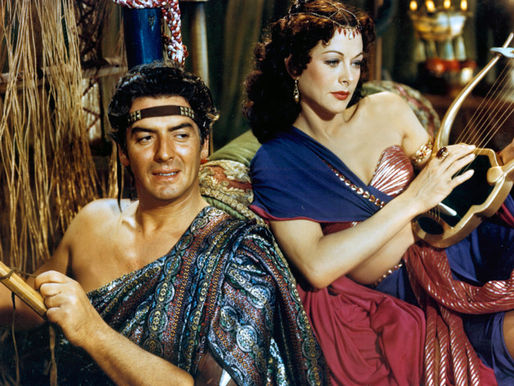top of page
Search
1940's
Classic Films from the 1940's


Bambi (1942)
When Bambi premiered in 1942, the United States was in the early months of its involvement in World War II, and Disney’s animation studio was still recovering from labour disputes and the financial aftershocks of Fantasia and Pinocchio.

Soames Inscker
5 min read


Dumbo (1941)
Of all the classic features to emerge from Walt Disney’s golden age of animation, Dumbo is perhaps the most paradoxical. It is at once the studio’s shortest feature and one of its most emotionally expansive. Born of necessity—crafted quickly and economically after the financial disappointment of Fantasia—Dumbo was never intended to be a major artistic statement.

Soames Inscker
5 min read


Fantasia (1940)
When Fantasia premiered in November 1940, it was unlike anything audiences had ever seen—or heard. Equal parts symphony, painting, myth, and fever dream, the film brought together classical music and hand-drawn animation in a visionary cinematic experience. Walt Disney’s third animated feature was also his riskiest, departing entirely from traditional narrative and character-driven storytelling.

Soames Inscker
4 min read


Pinocchio (1940)
When Walt Disney released Pinocchio in 1940, he wasn't simply following up on the unprecedented success of Snow White and the Seven Dwarfs—he was reinventing what animated cinema could be. More than eight decades later, Pinocchio remains a towering achievement: a film of extraordinary technical beauty, moral clarity, and emotional depth. It isn’t just a classic of animation.

Soames Inscker
4 min read


Fanny By Gaslight (1944)
A quintessential example of the Gainsborough melodramas that captivated wartime British audiences, Fanny by Gaslight (released in the U.S. as Man of Evil) is a moody, emotionally charged Victorian tale of passion, class, scandal, and survival.

Soames Inscker
4 min read


Love Story (1944)
In the middle of wartime Britain, when audiences yearned for solace, escapism, and romance, Gainsborough Pictures delivered a series of sweeping melodramas—and among them was Love Story (1944), a film that elegantly combines wartime anxiety, doomed love, and classical music into a richly sentimental drama.

Soames Inscker
4 min read


Pride and Prejudice (1940)
The 1940 film adaptation of Jane Austen’s Pride and Prejudice, directed by Robert Z. Leonard and starring Greer Garson and Laurence Olivier, stands as an intriguing fusion of Regency wit and 1940s Hollywood gloss.

Soames Inscker
4 min read


Twelve O'Clock High (1949)
Twelve O’Clock High is far more than just another World War II combat film. Released in 1949 and directed by veteran filmmaker Henry King, it is a sober, intelligent, and deeply affecting portrayal of military leadership under extreme duress. It eschews bombast and melodrama in favour of a grim realism and moral nuance that was rare in Hollywood’s post war era.

Soames Inscker
5 min read


Every Girl Should Be Married (1948)
In the golden age of romantic comedies, Every Girl Should Be Married (1948) stands out as a brisk, bright, and mischievously subversive entry. Directed by Don Hartman and starring Cary Grant alongside Betsy Drake—who would later become his real-life wife—the film explores courtship, gender roles, and the institution of marriage with a humorous, lightly satirical touch.

Soames Inscker
5 min read


A Letter to Three Wives (1949)
A Letter to Three Wives (1949) is a gem of mid-century American cinema, blending drama, satire, and subtle psychological insight with elegant storytelling and razor-sharp dialogue.

Soames Inscker
5 min read


Life With Father (1947)
Life with Father is one of the most beloved family comedies of classic Hollywood—a Technicolor jewel that blends wit, warmth, and an idealized vision of late 19th-century domestic life.

Soames Inscker
4 min read


Cluny Brown (1946)
Cluny Brown is one of those rare comedies that’s both effervescent and quietly radical. Directed by Ernst Lubitsch, in what would tragically be his last completed film, it is a parting gift of lightness laced with sharp social critique.

Soames Inscker
4 min read


To Be or Not to Be (1942)
Few films have dared to laugh in the face of tyranny with the audacity, intelligence, and finesse of Ernst Lubitsch’s To Be or Not to Be. Released in March 1942, during the darkest early days of World War II, the film stands as a singular achievement in cinematic satire—a work that blends comedy with political critique in a manner that feels both subversive and human.

Soames Inscker
4 min read


The Shop Around the Corner (1940)
The Shop Around the Corner is not just one of the most delightful romantic comedies ever made—it’s also a quiet masterclass in tone, character, and storytelling. Directed by the inimitable Ernst Lubitsch, it exemplifies his famed “Lubitsch Touch”: the light-handed, witty, emotionally intelligent style that could blend comedy and heartbreak with unparalleled grace.

Soames Inscker
4 min read


Born to Kill (1947)
Released in 1947 by RKO and directed by Robert Wise, Born to Kill is one of the darkest, most nihilistic examples of classic film noir. With a story centred on psychopathy, obsession, and moral collapse, it pushed the boundaries of what was acceptable in post war Hollywood. The film tells the story of a dangerous man and the even more dangerous woman who finds herself drawn to him, not despite his violence—but perhaps because of it.

Soames Inscker
4 min read


The Set-Up (1949)
The Set-Up (1949) is a film that, despite its modest budget and short runtime, remains one of the most compelling entries in the film noir and boxing film canon. Directed by Robert Wise and starring Robert Ryan and Audrey Totter, the movie presents a tense, real-time narrative of a washed-up boxer who refuses to go down quietly—both literally and metaphorically.

Soames Inscker
4 min read


Laura (1944)
Laura (1944) is one of the most celebrated films of the film noir genre, a hauntingly elegant blend of romance, mystery, and psychological complexity. Directed by Otto Preminger and adapted from Vera Caspary’s novel, Laura stands as one of the defining examples of mid-20th-century Hollywood's engagement with darker, morally ambiguous storytelling. It is a film that combines exquisite cinematography, striking performances, and a narrative steeped in mystery and intrigue.

Soames Inscker
7 min read


Samson and Delilah (1949)
Samson and Delilah (1949), directed by the legendary Cecil B. DeMille, is a grandiose spectacle of biblical proportions that combines larger-than-life action, dramatic storytelling, and lavish Technicolor cinematography to create a timeless epic.

Soames Inscker
6 min read


Going My Way (1944)
Released during the final years of World War II, Going My Way (1944) is a classic example of a film that blends humour, sentimentality, and musicality to create a lasting emotional impact.

Soames Inscker
6 min read


The Fallen Idol (1948)
The Fallen Idol (1948) is a quiet masterpiece of psychological tension, moral ambiguity, and childhood perception. Directed by Carol Reed in one of his finest collaborations with writer Graham Greene (preceding their celebrated The Third Man), the film is a study in how innocence and misunderstanding can transform the banal into the tragic.

Soames Inscker
5 min read
bottom of page


